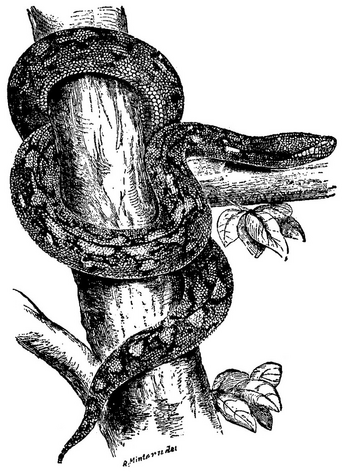Colophon#
This book was produced using the Sphinx Documentation Generator. This in turn uses a bunch of other Python packages that have all been made available by their developers. The theme is Sphinx {book theme}.
The main font in the PDF version is Bitter. Some text is in Lato. The code samples are in Cascadia Code.
The whole thing was cobbled together with PyCharm, with Git and GitHub keeping track of things. GitHub Copilot has chipped in now and again.
The cover image shows a Reticulated Python and is taken from the 1911 Edition of the Encyclopedia Britannica, which observes as follows. Who knew?
PYTHON, a genus of very large snakes of the family Boidae (see Snakes) inhabiting the tropical parts of Africa, Asia and Australia. They differ from the true boas (q.v.) with which they are often confounded by carrying a few teeth in the premaxilla, by the double row of subcaudal shields and by the possession of a pair of supraorbital bones. Most of them have pits in some of the upper and lower labial shields.
Python reticulatus is the commonest species in Indo-China and the Malay Islands; four upper labial shields on either side are pitted. It is, next to the Anaconda, one of the largest of all snakes, some specimens being known which measured about 30 ft. in length. P. molurus, scarcely smaller, is the python or rock-snake of India and Ceylon. The African species are much smaller, up to 15 ft. in length, e.g. P. sebae of tropical and southern Africa and the beautiful P. regius of West Africa. P. spilotes is the “carpet-snake” of Australia and New Guinea. A small relative of pythons is Loxocemus bicolor of South Mexico, the only New World example.
The giant pythons could no doubt overpower and kill by constriction almost any large mammal, since such snakes weigh hundredweights and possess terrific strength, but the width of their mouth—although marvellously distensible—has, of course, a limit, and this is probably drawn at the size of a goat. Before a python swallows such large prey, its bones are crushed and the body is mangled, into the shape of a sausage. The snake begins with the head, and a great quantity of saliva is discharged over the body of the victim as it is hooked into the throat by the alternately right and left forward motions of the distended well-toothed jaws. If for any reason a snake should disgorge its prey, this will be found smothered with slime. Hence the fable that they cover it with saliva before deglutition.
Most pythons are rather ill-tempered, differing in this respect from the boas. They are chiefly arboreal, and prefer localities in the vicinity of water to which mammals and birds, their usual prey, resort. They move, climb and swim with equal facility. The female collects her eggs, sometimes as many as one hundred, into a heap, round which she coils herself, covering them so that her head rests in the centre on the top. In this position the snake remains without food throughout the whole period of incubation, or rather keeping guard, for about two months.
